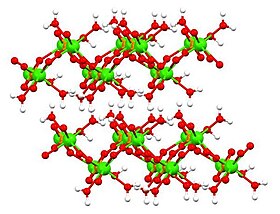Calcium hydrogen phosphate
 |
|
 |
|
| Names | |
|---|---|
|
IUPAC name
Calcium hydrogen phosphate dihydrate
|
|
| Other names
Calcium Hydrogen Phosphate
Phosphoric acid, calcium salt (1:1) |
|
| Identifiers | |
|
7757-93-9 7789-77-7 (dihydrate) |
|
| 3D model (Jmol) | Interactive image |
| ChemSpider |
94606 |
| ECHA InfoCard | 100.028.933 |
| PubChem | 104805 |
| UNII |
L11K75P92J |
|
|
|
|
| Properties | |
| CaHPO4 | |
| Molar mass | 136.06 g/mol (anhydrous) 172.09 (dihydrate) |
| Appearance | white powder |
| Odor | odorless |
| Density | 2.929 g/cm3 (anhydrous) 2.31 g/cm3 (dihydrate) |
| Melting point | decomposes |
| 0.02 g/100 mL (anhydrous) 0.02 g/100 mL (dihydrate) |
|
| Structure | |
| triclinic | |
| Hazards | |
| NFPA 704 | |
| Flash point | Non-flammable |
| Related compounds | |
|
Other anions
|
Calcium pyrophosphate |
|
Other cations
|
Magnesium phosphate Monocalcium phosphate Tricalcium phosphate Strontium phosphate |
|
Except where otherwise noted, data are given for materials in their standard state (at 25 °C [77 °F], 100 kPa).
|
|
|
|
|
| Infobox references | |
Dicalcium phosphate is the calcium phosphate with the formula CaHPO4 and its dihydrate. The "di" prefix in the common name arises because the formation of the HPO42– anion involves the removal of two protons from phosphoric acid, H3PO4. It is also known as dibasic calcium phosphate or calcium monohydrogen phosphate. Dicalcium phosphate is used as a food additive, it is found in some toothpastes as a polishing agent and is a biomaterial.
Dibasic calcium phosphate is produced by the neutralization of calcium hydroxide with phosphoric acid, which precipitates the dihydrate as a solid. At 60 °C the anhydrous form is precipitated:
To prevent degradation that would form hydroxyapatite, sodium pyrophosphate or trimagnesium phosphate octahydrate are added when for example, dibasic calcium phosphate dihydrate is to be used as a polishing agent in toothpaste.
In a continuous process CaCl2 can be treated with (NH4)2HPO4 to form the dihydrate:
A slurry of the dihydrate is then heated to around 65–70 °C to form anhydrous CaHPO4 as a crystalline precipitate, typically as flat diamondoid crystals, which are suitable for further processing.
Dibasic calcium phosphate dihydrate is formed in "brushite" calcium phosphate cements (CPC's), which have medical applications. An example of the overall setting reaction in the formation of "β-TCP/MCPM" (β-tricalcium phosphate/monocalcium phosphate) calcium phosphate cements is:
Three forms of dicalcium phosphate are known:
The structure of the anhydrous and dihydrated forms have been determined by X-ray crystallography. The dihydrate (shown in table above) adopts a layered structure.
...
Wikipedia

